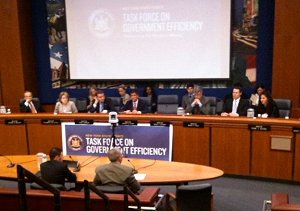
On April 20th the State Senate’s Task Force on Government Efficiency released a 41-page report concluding that there was $210 million in wasteful spending at New York State Department of Transportation and $60 million in potential cost savings. Outsourcing to consultants, overtime hours and nighttime work were fingered as the primary culprits. Follow-up testimony, given at the May 5 public forum, presented no clear or quick solutions to what is evidently a convoluted mess.
According to Tom Comanzo, Vice President of the Public Employees Federation (PEF), the cumulative effect of an aggressive, 20-year policy of labor cutbacks, hiring freezes, and early retirement has been a seriously understaffed Department. Today, NYSDOT has a quarter of the engineers it had in 1994 (4,301 vs. 1,073), and to achieve a fully-staffed operation, it would need to hire 2,500 more engineers statewide. This long-term shrinkage of the labor force has coincided with an increase in the workload. According to Comanzo, 60% of engineering work is currently carried out by consultants statewide; in New York City, 90% is.
Sue Stepp of NYSDOT’s Region 8 pointed out to MTR that Gov. Paterson’s plan to furlough state workers (which was temporarily blocked by a federal judge last week) would have affected NYSDOT employees but not consultants. Therefore, she said, it would have increased outsourcing and further exacerbated problems the regional offices have had with staff recruitment and retention—especially downstate, where engineers gravitate towards higher-paying private consulting firms.
This staffing crunch has already been worsened by the federal stimulus, Stepp said. The legislation allowed stimulus funds to go to the Federal Highway Administration to hire additional staff, but not the state DOTs that are processing the projects. According to Stepp, while the FHWA provides oversight, the real “boots on the ground” are in the regional offices. So while the stimulus was supposed to flood communities with new construction jobs, the lack of staff (or the ability of staff) at NYSDOT’s regional offices has been a bottleneck to projects actually getting out the door. (New York has, in fact, lagged behind many of its peers in spending stimulus cash.)
At the forum, Thomas Coté of the American Council of Engineering Companies (ACEC) fired back that PEF’s testimony that consultants cost more was based on “outdated and biased studies.” He contended that public employees actually cost more because of their “lucrative benefits” and because they’re not trained as well as private consultants. Acting Commissioner Gee added a third voice to the pool, stating that although there may be evidence that outside consultants are more expensive than staff, the difficulties of hiring civil service employees means that heavy reliance on consultants isn’t going away anytime soon.
The point of contention was balance and how to achieve the best bang for the buck—no one was arguing that all work should be done in-house or outsourced, and there was general agreement that the department needs more resources. Still, those who have worked with NYSDOT in the past know that there is definite room for improvement and that simply throwing more resources at the agency will not do the trick.
New York’s next governor will need to address this and general dysfunction within the agency by selecting a State DOT Commissioner with the leadership skills to overhaul the agency’s spending and policies, and the managerial skills to figure out how to efficiently get projects out the door. Without such changes, convincing the State Legislature to give it more resources may be an impossible task.
Image: Photo by Nadine Lemmon/TSTC.

There is a rapid growth of Outsorcing these days as manufactures try to cut cost and maximize profit.*.~